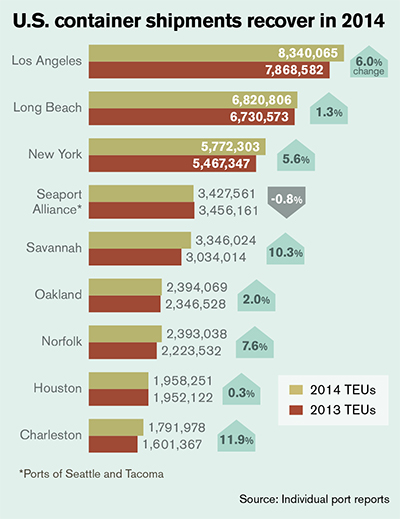2015 State of Logistics Ocean: Ocean cargo still faces stiff headwinds
The container shipping industry has been highly unprofitable over the past five years, note analysts with McKinsey and Company. Making things worse, earnings for ocean carriers have been exceptionally volatile.
“Several factors are responsible,notably trade’s spotty recovery from the global financial crisis as well as the redoubled efforts by corporate shippers to control costs,” says Timo Glave, an associate principal in McKinsey’s Copenhagen office. “However, some of the pain is self-inflicted. As in past cycles, the industry extrapolated the good times and foresaw an unsustainable rise in demand—and now it’s building capacity that will be mostly unneeded.”
These problems are real and significant, and largely beyond the power of any one carrier to address. But carriers cannot afford to throw up their hands and accept their fate. Hidden beneath these issues—and driving them to a degree—is another set of challenges that shipping lines can readily take on.
Across the enterprise—in commercial, operations, and network and fleet activities—shipping lines have opportunities to improve performance. In sales, for example, carriers often confuse their costs with the value received by customers and fail to charge a premium for services for which shippers will pay more. In operations, many lines treat bunker as just another cost of doing business.
“In fact, fuel presents many opportunities, not just in procurement, but also in consumption,” observes Martin Joerss, a McKinsey director in its Beijing office. “In network design, more than a few shipping companies use outmoded approaches to design their routes. Instead, new and more powerful systems use algorithms to make better, more effective decisions about networks, and these need to be put to better use.”

David Rosen, CEO of Idiliti Maritime Consulting, agrees, noting that there is no connection between the size of the carrier and its success. “There is no connection between fleet vessel sizes and business results,” says Rosen. “The basic premise is to achieve lower costs with large vessels providing lower slot costs. However, this is coupled to the need to fill the ships, financial risk, loss of control, and independence due to the need to cooperate—all resulting in a loss of competitive differentiation.”
Carrier schedule reliability is one such differentiator, say analysts at London-based Drewry Maritime Research. Their latest findings indicate liner schedule reliability improved for the fourth consecutive month in May as the aggregate, on-time
performance for the three core East-West trades jumped by 4 percentage points to reach a new data series high of 71.6 percent.
The latest monthly increase follows a similar rise in April and was the result of a moderate improvement in Asia-Europe container service reliability. “The continued improvement in container service reliability is encouraging news for shippers, who could be said to be getting much better value for their money from carriers at present considering that reliability is at a peak while spot freight rates are at historical lows,” says Simon Heaney, senior manager of supply chain research at Drewry.












